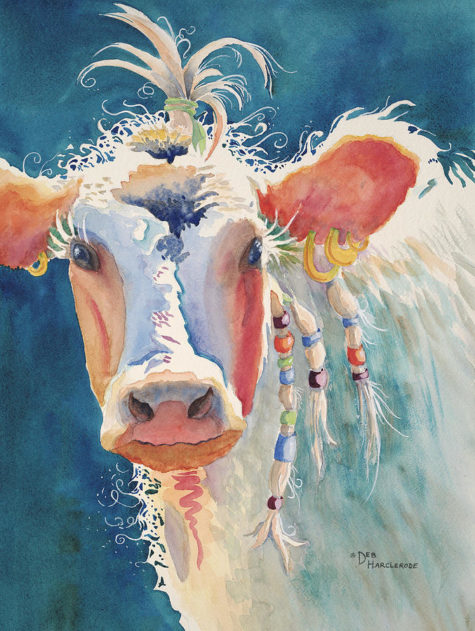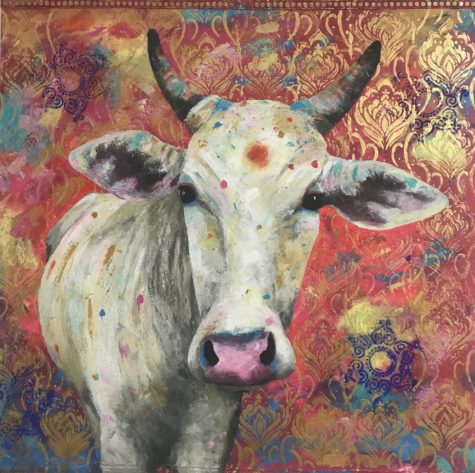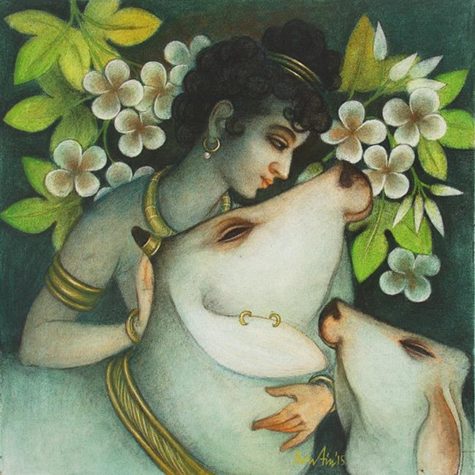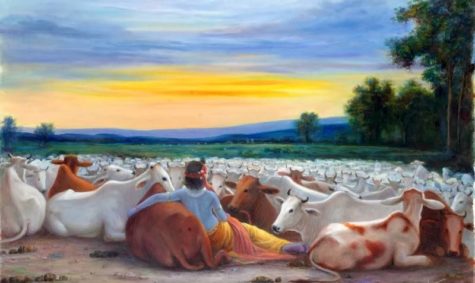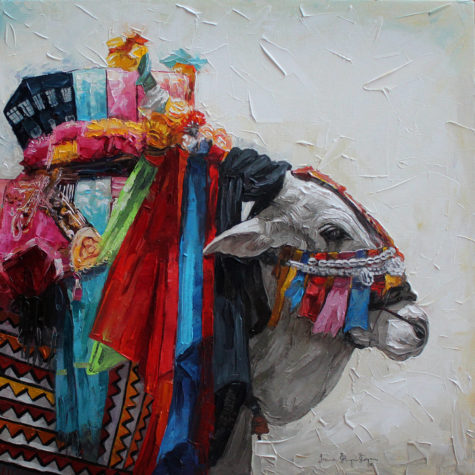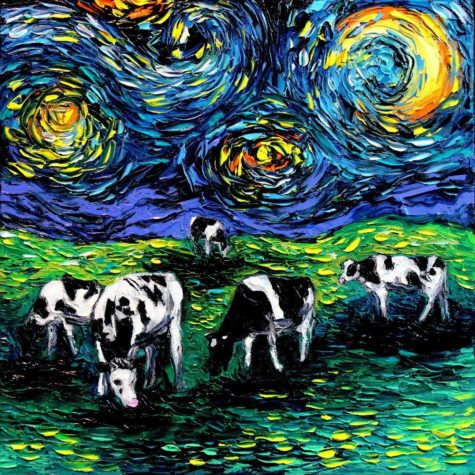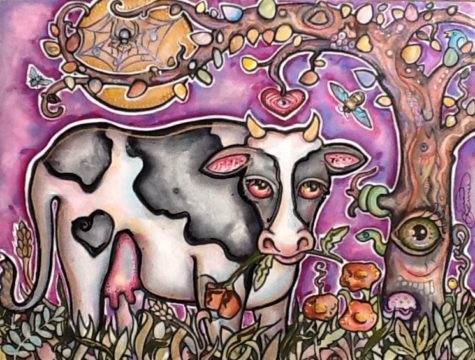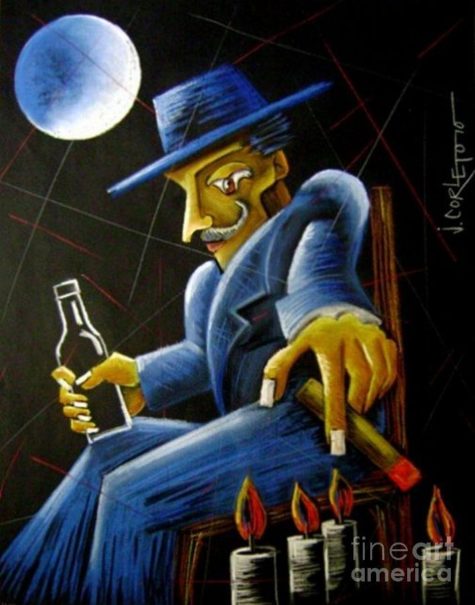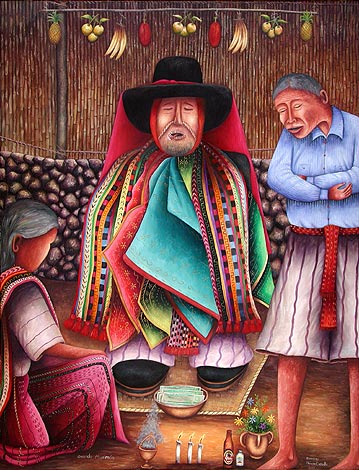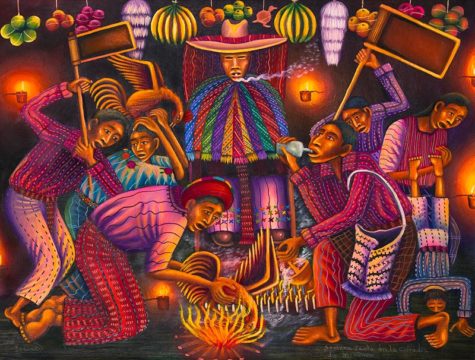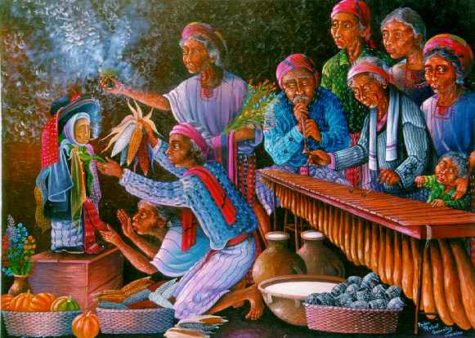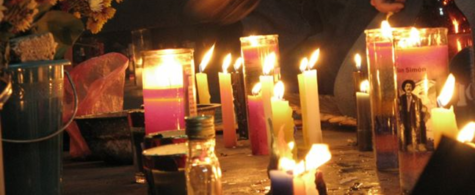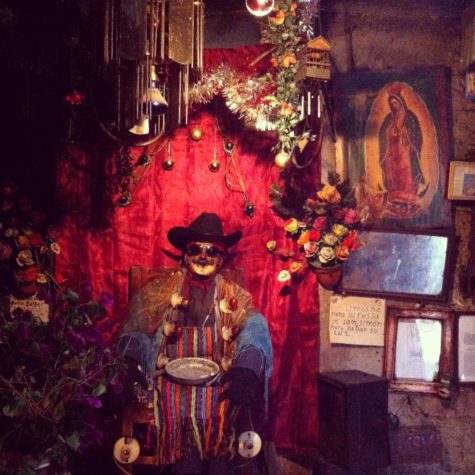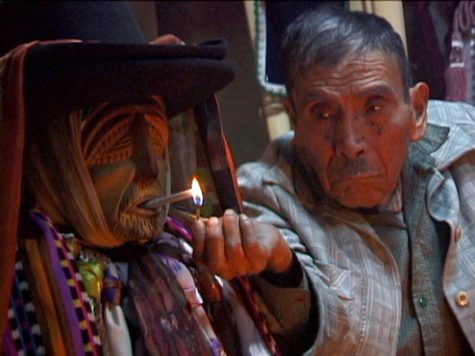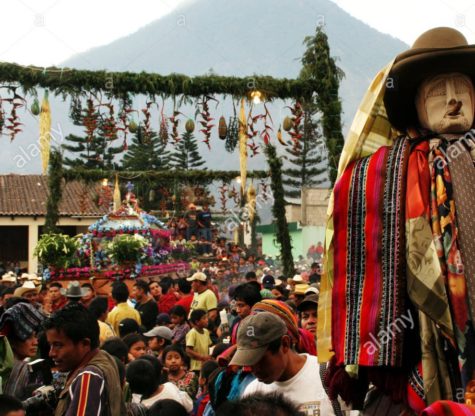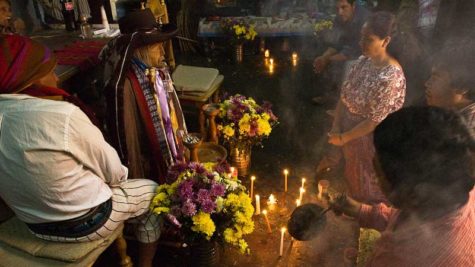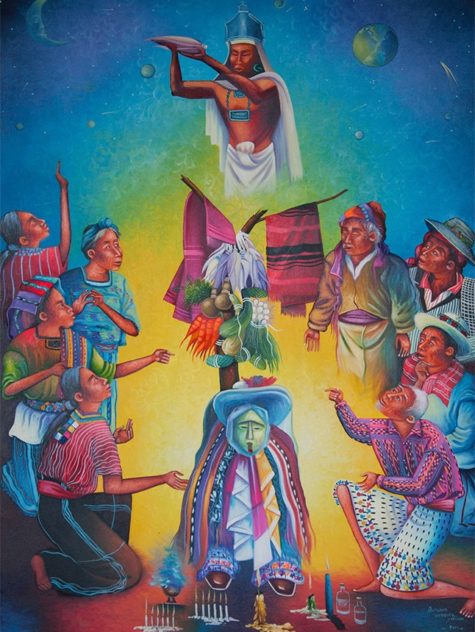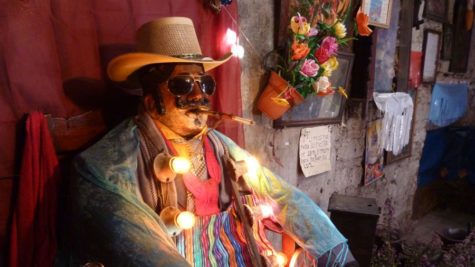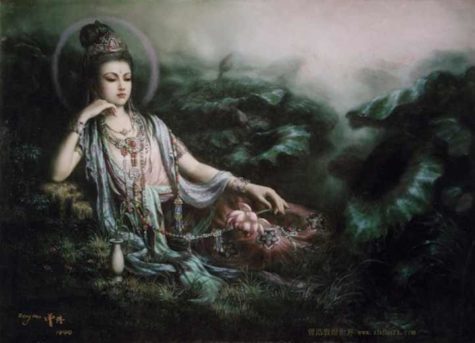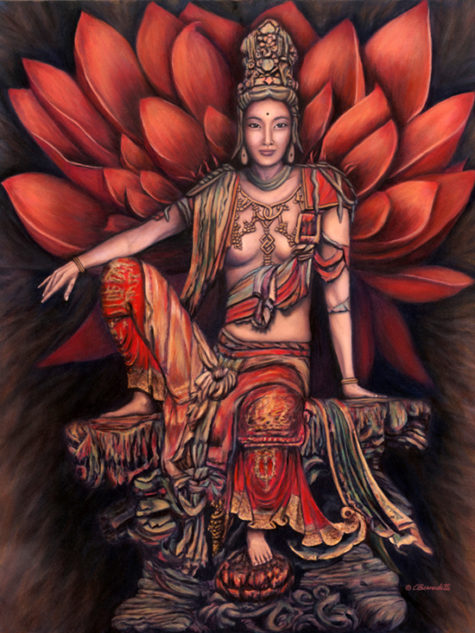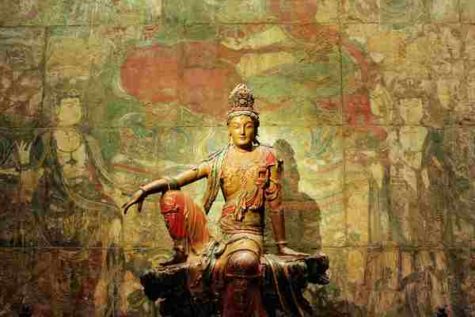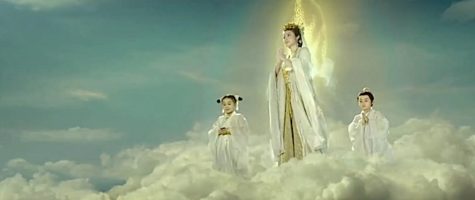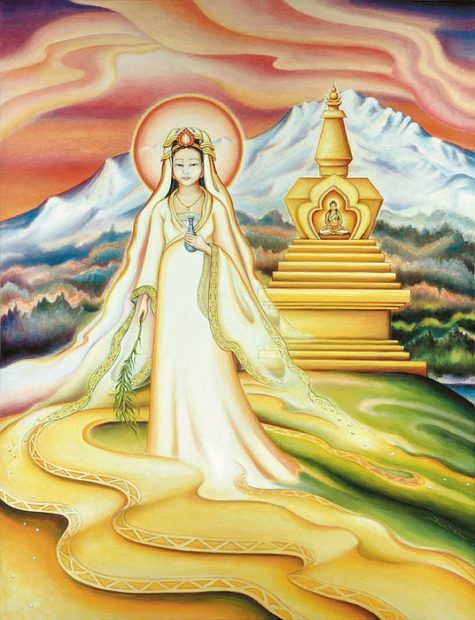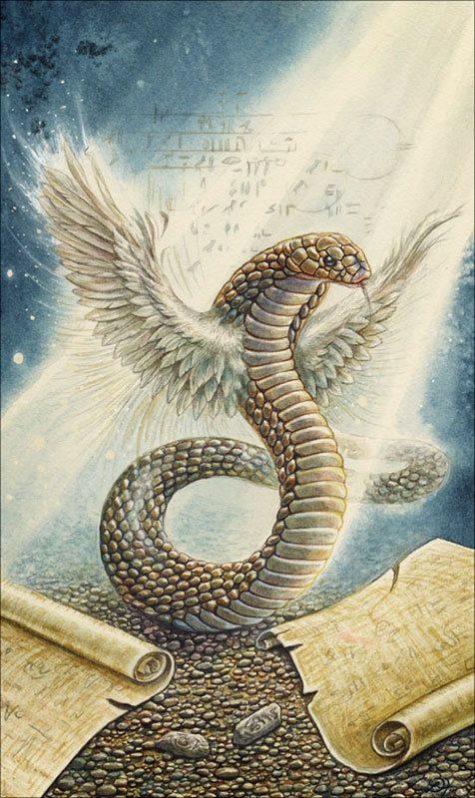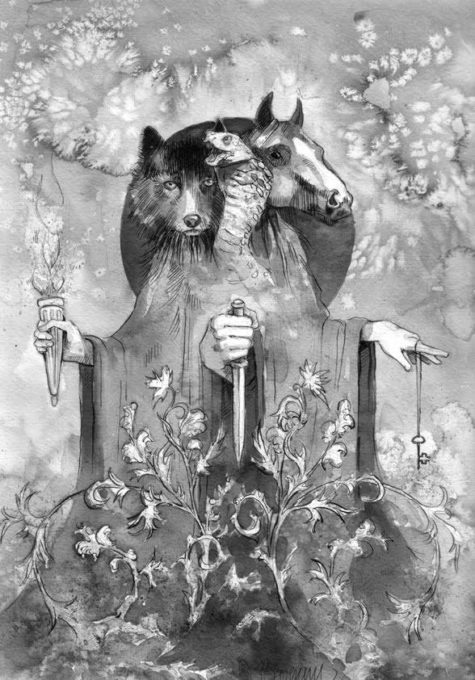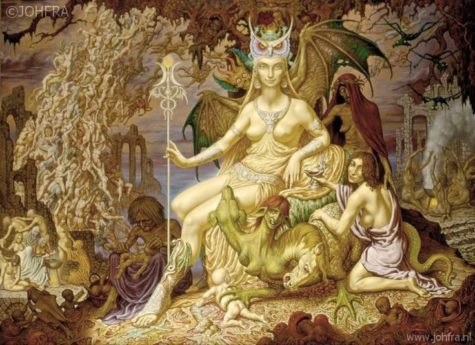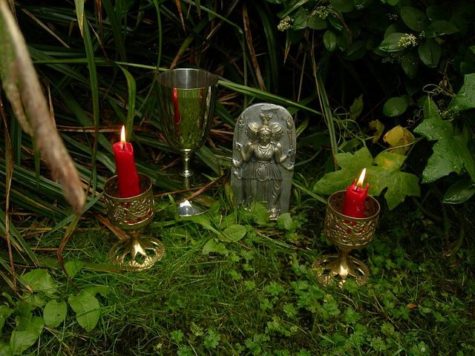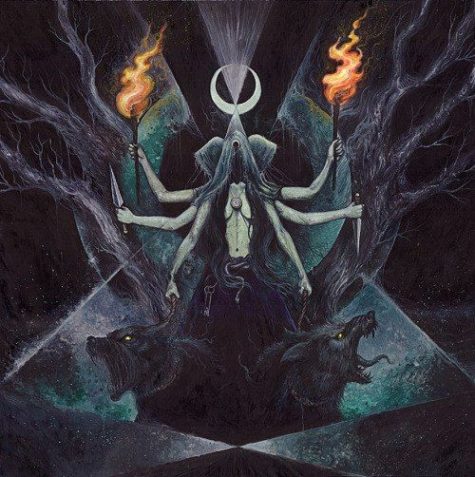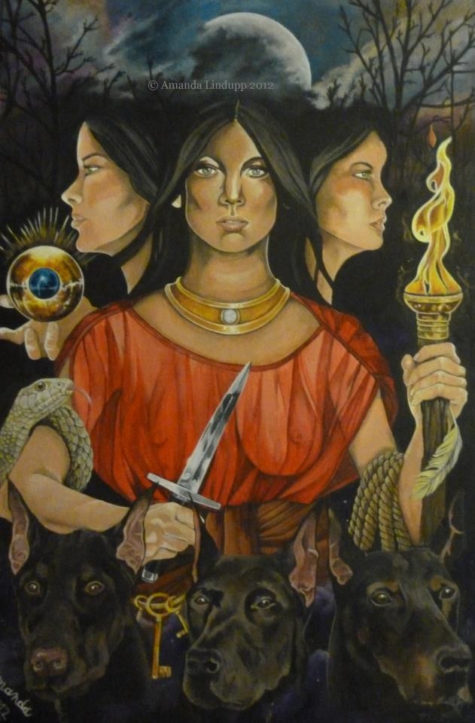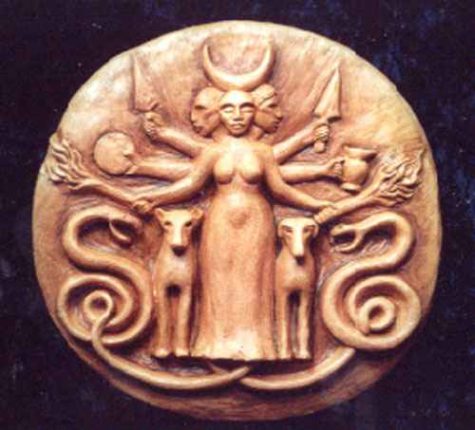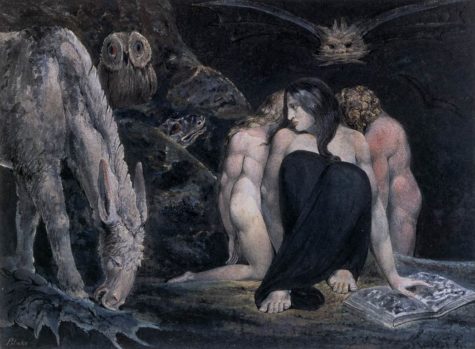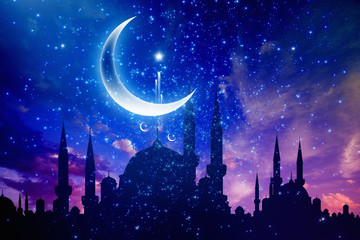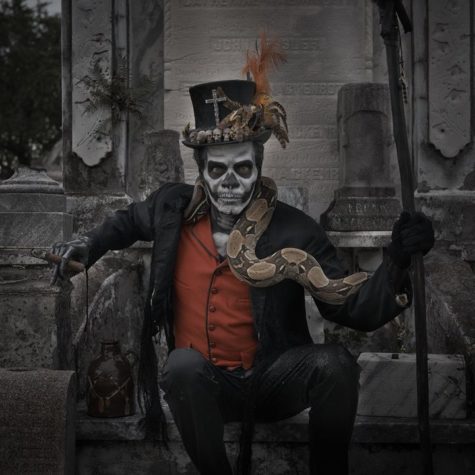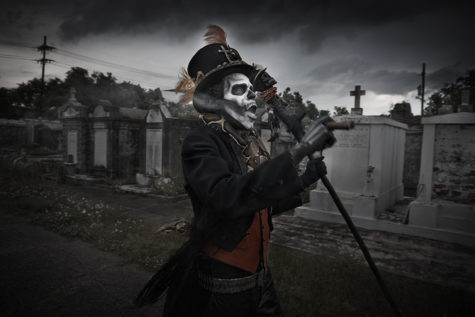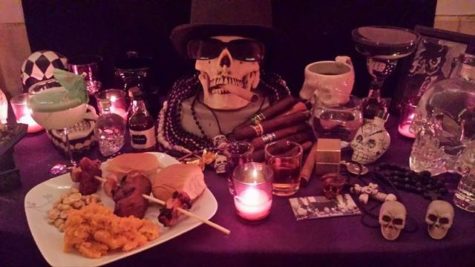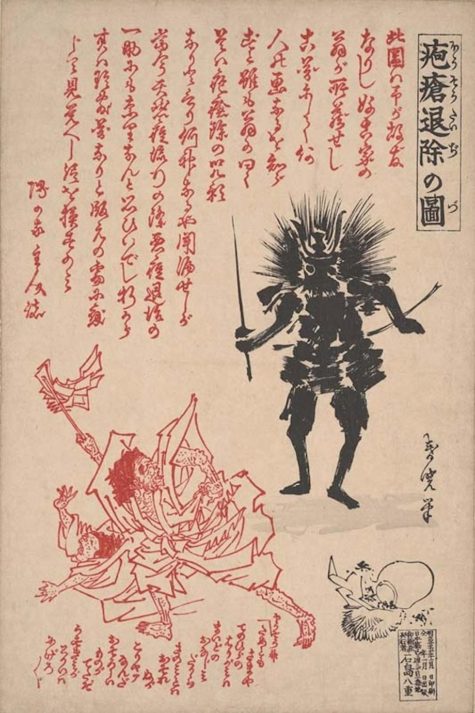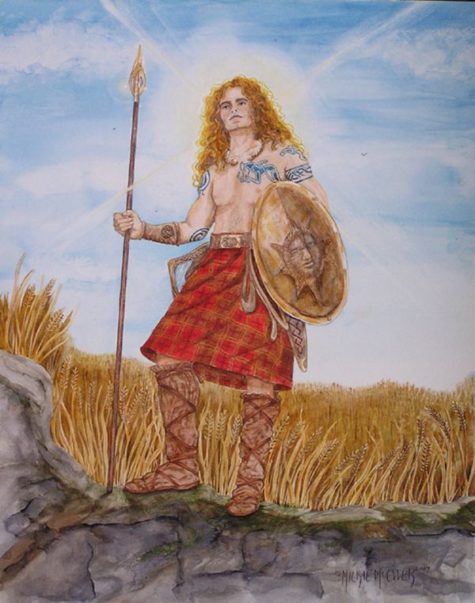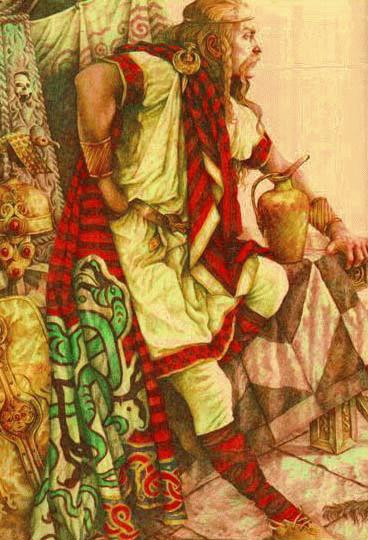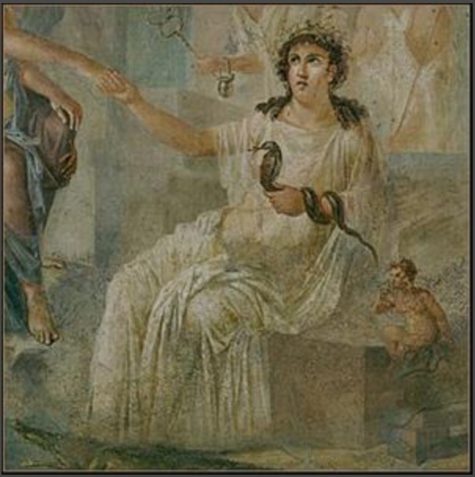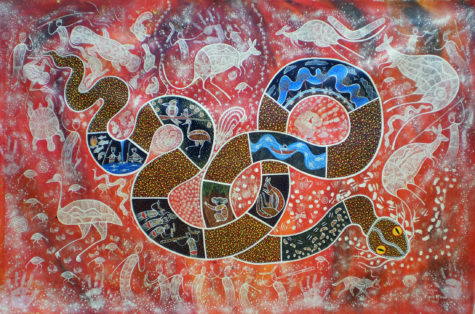Healing
Because of its milk that is a staple food for many human beings, the Cow is arguably one of the most useful animals in the world. It was one of the first animals domesticated by humans, and its symbolic importance is rich. It is emblematic of fertility, abundance, wealth, the universal Mother, and of rebirth. The Cow is also a gentle and compliant creature.
In Vedic literature the Cow is also a symbol of abundance and fertility as it represents both earth and sky. To Hindus and Buddhists, symbolism of the Cow deals with patience and holiness.It is considered India’s most sacred animal. The calm, tender nature of the Cow wins this right among the Buddhists.
The Cow as a sacred animal is a fundamental part of Hindu iconography. In India the Cow is so revered, and treated so gently, that it often causes a traffic hazard as it ambles along busy city roads. There are several reasons for the sacred status given to the creature. Not only does the Hindu faith have respect for all animals (vegetarianism is a tenet of the faith), but the God Krishna was a cowherd for a time, and one of his names is Bala Gopala, “the child who protects the cows.”
Hindu deities rule over each and every part of the Cow. During times of famine, the Cow is far more useful as a creature that can produce limitless amounts of milk, then as a dead beast that would provide meat for a limited period only.
In Egypt the Cow was personified as Ahet, the mother of the Sun itself. To make themselves fertile Egyptian women wore amulets of the Goddess Hathor, with the head of a Cow, in her guise as the Creator.
In Norse mythology the Cow makes an appearance as Audhumla, the mother-ancestor of all living things, whose utters emitted the four rivers of power – these provided nourishment for the giants (primarily the first giant, Ymir) that ruled the First World.
In Celtic mythology the Cow is sacred to the Mother Goddess Brigit who also governs the Earth, mothers, children, health, nurturing, providence, and the full range of the Female element of the universe. This symbolism remains consistent with that of many other cultural settings and supports Cow as representing life’s fragile beginnings and the necessity to safeguard and restore those who have no voice or support.
In Greek myth, one of the names for the great Cow was Europa, which means “full Moon.” The stars were said to be the children of Europa.
In Lancashire folk-speech, the name “cow’s lane” was sometimes given to the Milky Way, the traditional path of souls, as it was also in some parts of Germany. This may be connected with the old north European belief that whoever gave a cow to the poor during his life would be guided by that cow along the perilous soul-road after his death, and so would be sure of reaching Heaven in safety.
Once, there was a custom whereby the cow was brought to the sickroom, and in what must have been a distressing and rather frightening ritual, the dying person was encouraged to grasp the tail of the cow as he breathed a last breath.
This psychopomp aspect of the Cow is still celebrated in the Nepali festival called the Gai Jatra or Cow Festival. In a boisterous celebration, every family that has lost a member during the course of the year has to take part in a procession, leading a Cow, or if no animal is available, then a child dressed in a cow costume is considered to be a fair substitute. The Cow is believed to guide the soul on its final journey, including a voyage through the Milky Way, the constellations of stars said to be the milk splashed by the great Cow that was the mother of the Universe.
Red cows appear in some pagan creeds as personifications of the dawn, or clouds, or lightning. It is possible that they had some special significance for the ancient Hebrews also, since it is definitely stated in Numbers 19:1 that the victim offered for the purification of the people must be “a red heifer without spot, wherein is no blemish, and upon which never came yoke.”
In England the milk of a red cow was formerly supposed to be superior to any other, and to have healing properties. Such milk is often specifically mentioned in 17th and 18th century medical books as an essential part of remedies for various ills, particularly for consumption and chest ailments. Red is, of course, a life-giving color in mythology and folk tradition alike because it is associated with fire and with blood, and red objects of various kinds figure constantly in healing charms and folk remedies.
According to a French legend, Cows always have a sweet breath because when Our Lord was born in the stable at Bethlehem, a Cow, seeing Him shivering in the cold, warmed Him with her breath and drew the hay over Him with her lips. As a reward for this act of kindness, she was promised that her breath, and that of all her descendants, should ever afterwards be sweet, and in addition, she was given the privilege of carrying her calf for nine months, like a Christian woman with a soul to be saved.
Cow Symbolism
The Cow is a lunar symbol, aligning itself with feminine (yin) qualities among the Chinese yin-yang energies. A quick-list of Animal symbolism of the Cow would include:
- Patience
- Nourishment
- Abundance
- Fertility
- Female Power
- Potential
- Possibility
- Calming
- Grounded
- Provision
- Beginnings
Because you’re seeking out Cow symbolism and meaning, a deep stirring must be happening in your soul. Cows represent motherhood, Mother Gaia, and the Mother Goddesses. Take time to meditate on all Mother Cow has to offer. She is a sacred reminder of fertility, birth, and nurturing.
- When Cow appears as your Spirit Animal trust that the mighty storm will pass and you’ll be OK.
- Cow as a Totem Animal belongs to those with profound Mother Goddess instincts.
- Call in Cow as your Power Animal when your soul needs TLC.
The Cow Totem
Those who know Cow as their Totem Animal supply a sense of stability and solid, loving, growth-oriented relationships with self, others and the environment.
Cow people have the ultimate “mother’s intuition.” They can feel when others are out of sorts – when their auras are “scratchy” – and they always seem to know just what to say or do to help. Somehow, folks heal more quickly when in the company of Cow Totem Animal people.
If Cow is your Totem Animal, always remember that one cannot feed others from an empty trough. Though you were born with the natural instinct to take care of the world, YOU are part of it. Your needs are just as important as everyone else’s. A wise Cow mama know when to take a break and nourish her own mind, body, and spirit.
We should always work to have a positive and happy home environment. If we don’t, we should inquire deep within as to how we can change that. Calling upon the Cow animal totem, we can learn how to make basic changes that are needed to balance the joys in our surroundings.
Like its family member the bull, the Cow totem is highly connected to nature, the Earth, and its continuation through reproduction. Cows are very generous with their lives and behave in the most selfless of manners.
Among fertility and femininity, these mother creatures represent the virtuous traits of sustenance, abundance, potential, calming, grounding, and provision. They also serve as an uplifting sign of female power and prestige, since they are, after all, crucial to the continuation of any species.
New beginnings are also a theme associated with Cows in conjunction with their maternal auras. Through their pregnancy, birth, nourishment to their offspring, and ultimate bodily gifts, Cows show the entire life cycle in its bittersweet beauty from start to finish.
The female Cow totem is linked to its male counterpart, the bull, through the symbolism of fertility and reproduction. While the male totem exemplifies nourishment through its slaughter or sacrifice, a Cow symbolizes birth and motherhood.
Cow symbolism assists us in understanding and embracing fertility and the relationships necessary for it. It is a soft and nurturing creature that arouses the soft side in each of us. The two animals are directly connected, as they are both needed to create new life.
These animals illustrate both the masculine and feminine qualities that exist in every being. The bull is characterized by bold and rigid energies, while the Cow is far more gentle and tranquil. They remind us to constantly ensure that these energies are in harmonious balance.
Cows As Spirit Guides
The Cow is a very powerful Spirit Animal. While at first you might wonder about the value of such a guide in your life, there is much about Cow to respect.
Like many other animals, Cows as spirit guides have been revered in various religions and cultures around the world. In ancient Egyptian astrology, the Cow served several symbolic purposes, including being worshiped as the goddess of joy and maternal nourisher of all things.
Additionally, they remind us to nourish ourselves physically, mentally, and emotionally. If we neglect the basics of our lives, it will be impossible for us to live happily and thrive. Every day, you should ask yourself if you are eating the right foods, drinking enough water, and exercising both your body and your mind to remain healthy and alert.
Cow reaches out to those struggling with fertility offering motherly advice. You may not always like what Cow tells you (did you like everything your mother told you?), but the heart behind the Cow Spirit Animal is truly one of giving. She always wants what is best for both you and your proverbial herd.
When weathering a storm, be it emotional or physical, turn to Cow as your animal spirit guide and think of how firm Cows stand in vile weather. There is no moving a Cow and no influencing it, but for urgent matters of hearth and heart. Nonetheless, as you stand in your place of power, remember that Cow also gives you keen perceptions. Be on the alert for possibilities or potential peril.
If your spiritual path is working toward the greatest good, Cow guidance is a fantastic helpmate. She will stay with you compassionately with watchfulness, making sure you stay inside the spiritual boundaries you’ve set.
Cows are lunar, divine feminine energy. If you’ve ever looked into a Cow’s luminous eyes it’s easy to feel how loving they truly are. But, as soft and magickal as moonlight is, never forget it is the moon which is mighty enough to influence all the waters of the earth. The divine feminine is just like that. Pliable and giving, but it should never be mistaken for weak.
Cows are a simple creature that get their joys from life’s basic pleasures. From this, they aid us aid us in remembering to be easy going and live in the moment. Often times, we ignore the innocent and plain moments that make our lives wonderful.
If we can manage to clearly assess our lives, we will be reminded to thank our family members and those close to us for all that they do to make our lives joyful. Simply appreciating your community can change your mentality greatly, having positive effects on both your outlook and your body.
One of the Cow symbol’s main spiritual messages is to never take this for granted, for eventually this life will end.
Cow As A Power Animal
If you want to have children, consider carrying a carved Cow totem and invoke Cow as your Power Animal. Cows are powerful symbols of new life. That life need not necessarily be as a parent however. It can apply to new jobs, new homes, and new relationships.
Keep a Cow totem on hand when you need protection from negativity or nightmares. Like the Mother Goddess herself, Cow energy holds you close, reassuring that nothing will harm you.
As a power animal Cow calls on you to love fully. Look at the world and the wonders of creation and let that fill you with all the characteristics you most need to embrace life.
Note, however, that this power animal will not let you give and give and give without refilling. Those that serve need service, including you. Put out a cattle call and let people give back (it blesses them too).
Dreaming About Cows
Lessons of gratitude and the appreciation of sacrifice are prevalent in cow symbolism, especially when presented in our dreams, and we would do well to integrate them into our daily life.
A cow dream symbolizes some important issues. In Hindu culture, cows are sacred and represent fertility, nourishment, and motherhood. Cows also represent personality traits such as passivity and overall contentment. Seeing a cow in a dream is usually a positive thing, with the appearance of grazing cows, in particular, representing happiness and prosperity. Some ancient societies and some tribal societies measure a person’s wealth by how many cows he or she has.
The dream cow indicates that you obey authority figures without questioning them. It may represent maternal feelings or a desire within you to be taken care of. If you see a herd of cows in your dream, it suggests that you have a strong need to belong to a group. A herd of cows may also mean that you have a group of close friends that you enjoy. If the herd was disturbed or anxious in some way, it means that something or someone may be acting on your group of friends in such a way as to cause trouble and pull the group apart.
Dreaming of a field full of Cows portends improved finances or potentially a multiple birth in the family. A Cow grazing happily speaks of joy and contentment in the home. If the Cow represents self, it’s a signal that you need nurturing and spiritual nourishment.
The appearance of a cow with the face of a skeleton in your dream means that your mother or some mother figure in your life is acting coldly toward you or not responding to your needs. If you dream of cow with a calf, this is always a positive sign.
If you dream of being a cow, this suggests that you are afraid of being stupid. Dreaming of a sick cow suggests that some plans you’ve made for the future are threatened and require some action from you to avoid problems.
Because cows often represent motherhood, they are also representative of the feminine part of a man’s psyche. If you are a man, the dream of a cow suggests that you recognize this part of yourself and incorporate it into your life in order to attain greater psychological balance overall.
Dreams of cows are symbolic of peace, passivity, endurance, mothering, and humility.
Superstitions About Cows
An old English superstition says that cows kneel down on Christmas Eve and pay homage to Jesus. They speak in human voices, but anyone who hears them will die before being able to tell anyone about it.
Old farmers say that every herd has a “master cow” which leads the others into mischief. If a cow lows after midnight, it is a death omen for someone in the neighborhood, and similarly, if a cow lows three times in a man’s face, he has not long to live.
If a cow licks the forehead of another cow, it is a sign that their owner is about to die. It is also a sign of imminent death if a cow enters your property. Three cows means three deaths. Yet another reason for keeping your gates closed, especially if you live in the country!
It is important to wash your hands thoroughly after milking a cow. If you don’t, you will receive no milk on the following day.
- Cows that eat buttercups produce tastier butter.
- When out in the field an upright Cow tail foretells rain.
A cow’s breath is believed to have health-giving properties and people suffering from tuberculosis were at one time encouraged to sleep with the cattle.
If separating a calf from its mother, you should take a calf out of the barn backwards to prevent its mother mourning the loss of her child.
In Ireland a hare appearing with Cows on Beltane signify witches who are up to no good stealing away with fresh milk. The Scots believed that putting tar behind the Cows’ ears would keep the witch from succeeding.
Witches were also believed to be able to steal the milk of cows from a distance by means of a magical tether, the strands of which were plaited the wrong way. They could do the same by going through the motions of milking with a rope, or a pot-hook, or the legs of a stool, and sometimes they came in the form of hares and sucked the udders of cows lying out in the fields. When the true milking-time came around, such bewitched animals would give only a poor supply or no milk at all.
Various charms were used to counteract these thefts, one of which was to make the rope used to tether the animals’ feet out of horsehair, and to thrust a stick of rowan, or some other magickal wood, through it.
In an article in Folk-Lore (1895), a story is told about a Bernera farmer whose cows gave so little milk that he was sure they were bewitched. He used such a rope, with excellent results; but as soon as the cows were released, they all rushed to a certain woman’s house and began tossing at the walls. This was regarded by the local people as clear proof that the woman had previously bewitched them, and so strong was the feeling against her on this account that she had to leave the district.
In Discourse on Sympathy (1658) an old country belief is recorded that if milk boiled over and fell on the fire, salt must immediately be thrown on the place where it fell. If this was not done, the cow which gave it would suffer from an ulcerated udder.
Sources:
- Animal Speak by Ted Andrews
- What Is My Spirit Animal?
- The Encyclopedia of Superstitions
- Element Encyclopedia of Secret Signs and Symbols
- What’s Your Sign
- Titles: The Old Man; The Uncle
- Also known as: Maam; Don Pedro; Saint Simon; Brother Simon; Brother Peter
- Pronounced: Mah-shee-mon
- Origin: Maya
Maximón is a master shape shifter, reconciling religious traditions and offering guidance to indigenous Mayans who venerate him in Guatemala. He is also a heavy drinker and smoker.
Maximón, also known as San Simón, is an important Mayan folk saint in Guatemala represented by a dressed up wooden effigy sitting on a chair who, unlike other saints, smokes cigars and drinks alcohol. Today Maximón is actively worshiped as part of what we could refer to as “folk Catholicism“, especially in the highlands of Guatemala.
His visitors travel from near and far to come see him and ask for protection, money, to be cured or even find a husband. Maximón receives everyone – men and women, villagers and urban dwellers, prostitutes and entrepreneurs – who come with many offerings including tobacco, liquor, money and tortillas (his favorites).
Christian missionaries who came to Guatemala to convert the local people encountered the primordial Mayan deity Maam, Lord of the Universe. Attempts to syncretize him to Saint Simon backfired. Instead of the Mayan god fading discreetly into the identity of the saint, Maximón, as he became known, took on a whole new life and personality of his own: defiant, rambunctious, anti-social. The Church then attempted to syncretize him with Judas Iscariot or even Satan, but it was too late. All they did was enhance Maximón’s outlaw image and make his devotees love and admire him even more.
Maximón’s appearance varies greatly by location. While he’s popularly depicted as a man in a suit and hat, this isn’t a constant. In Santiago Atitlán, he wears colorful garlands and scarves, while in Zunil, he wears sunglasses and a bandanna.
Although his wardrobe has been updated and modernized, Maximón is an ancient, primordial spirit. He has survived numerous attempts to suppress his veneration and is now more popular than ever, venerated throughout the Americas and Europe.
He is generally benevolent, associated with healing, prosperity, and protection. In Guatemala, Maximón is traditionally invoked for protection for or from anti-government forces. Nothing is beyond his assistance or outside his jurisdiction. Maximón is said to represent both light and dark, and to be a trickster. He is both a womanizer and a protector of couples. Be wary.
Maximón is a crossroads spirit. He mediates between the living and the dead, people and spirits. He serves as a bridge between malevolent and benevolent spirits. Maximón is an extremely responsive spirit who works for comparatively modest offerings.
He makes people’s dreams come true. He challenges believers. He heals. He helps overcome obstacles. He stands against injustice. He dances the night away. He brings wealth and success. Fertility and prosperity. He wins the heart of women and protects from infidelity. In fact, he is the lord of sexuality standing for all unresolved matters of a moral nature.
Legend says that one day he was caught sleeping with the wives of the village men who had supposedly gone to work. Furious, they cut his legs and arms off. So Maximón also makes mistakes, which makes it easier for people to relate to him. Sometimes when he brings justice to a person, it is even at the expense of another. Thus, he sits at a crossroads between being both a deity and a trickster, a friend and a fiend.
Maximón may indicate his presence via the smell of cigar smoke when no cigars are present. He visits in dreams.
Spells, Rituals and Operations:
Maximón is invoked in numerous magickal spells, rituals, and operations.
- Protection of your business
Place his image in your shop or store to stimulate better business and for luck, money, and protection. Maximón foils and/or punishes shop-lifters and thieves
- Abusive people or situations.
If someone abuses you, whisper your needs directly into the ear of Maximón’s image. Place the person’s photo under Maximón’s left foot, or write a note and place it there.
- Requests for love.
Coil a rope around his image (even around his neck!) to show him that you need his help capturing someone’s heart or alternatively, for hobbling competing suitors. Whisper in his ear to tell him what you need.
- Marital issues.
Wrap a rope around his image to keep your spouse from running off with another.
- Maximón is invoked to heal addictions.
He will accept request on behalf of others, especially addicts. He may be invoked on behalf of someone else who cannot or will not ask him themselves. It is not necessary to tell the person that you have requested Maximón’s blessings on their behalf. The deal is between you and Maximón. Make offerings and tell him what the other person needs. However, even if the other person reaps the blessings, Maximón is doing YOU the favor; YOU must fulfill any vows or promises made.
Colors and Candles
An elaborate color scheme is used to communicate with Maximón. Those who are experienced candle-burners may choose to retain their own candle color associations, but the following color chart is commonly used to communicate desires and petitions to Maximón. Burn the color candle that closest represents your needs:
- Black: Protection from envy, jealousy, enemies, and the deliberately cast Evil Eye
- Blue: For good luck, employment
- Brown: Protection from resentment and the accidentally cast Evil Eye
- Green: Business, prosperity, cash
- Light Blue: Cash, travel, education, and happiness
- Pink: Hope, health
- Red: Love, fidelity
- White: Protection of children
- Yellow: Protection for adults
Offerings:
Hats, silk scarves, flowers (he likes bougainvilleas, carnations, and gladioli), fruit, tobacco products especially cigars, copal incense, water, Coca-Cola, tequila, aguardiente. An elaborate offering when you really need a big favor or as a fulfillment of a vow is forty candles plus copal incense.
Images:
The oldest images of Maximón consisted of masks and mysterious wrapped bundles. However a modern votive image has also evolved possibly based on the only known existing photograph of shaman, wizard, and Maximón devotee Francisco Sojuel (died circa 1907), credited with crafting the first modern Maximón mask. This image depicts Maximón as a mustached man wearing a black suit and a Stetson or similar hat. He is usually, but not exclusively, depicted sitting.
The modern image closest to his ancient one consists of a bundle of fabric topped with one or more Stetson hats.
The name Maximón is often interpreted as deriving from Maam and Simon. Another theory suggests that it derives from Maam and ximon, a Mayan word that may refer to a bundle or the act of “tying up,” essentially creating a bundle. The use of bundles as sacred objects is not uncommon in indigenous American spiritual and magickal traditions.
Votive images range from pocket-size to life-size. The mouth of his statue may be open so a real cigar may be inserted.
Alternatively, the statue may be designed so that the cigar can be placed in his hand. Ashes and stubs from offerings are collected and preserved. Placed in a small charm bag they serve as amulets, allegedly bringing good luck. Sometimes tubes are inserted into statues so Maximón can actually “drink.” Liquor passing through his system is then reserved for ritual use.
Maximón often accumulates an extensive wardrobe. He is a fastidious spirit whose clothes must be kept clean. The rinse water used when hand-washing his clothes may be preserved as Holy Water, or magickally charged water. It is said to have magickal and healing powers.
Festivals and Sacred Sites:
Guatemalan festivals dedicated to Maximón coincide with Holy Week, culminating on Good Friday.
One of the aspects of Maximón is that he can appear in any form. During Easter week he takes on the form of Judas Iscariot, who in betraying Jesus became the catalyst who put into action the events ended in the crucifixion of Jesus. Judas (Maximón) then hangs himself.
What has sometimes been described as a lynching in Guatemala, is actually a Easter Week re-enactment of the crucifixion where the hanged man is Maximón in his guise as Judas Iscariot. The Tz’utuhil Maya workers on the fincas [plantations] on the coastal side of the Volcano Atitlán have brought their customs with them from the highlands in Santiago Atitlan.
Maximón is the subject of innumerable home shrines, but his major public shrine is in Lake Atitlan, Guatemala.
In Santiago Atitlán, Maximón’s effigy resides in a different household every year. His image is normally only taken out of this house during Holy Week, whereafter it will change households, but is on display year-round due the popularity of pilgrimages. The effigy of Maximón in Santiago stays with one of five families, who are members of a religious brotherhood looking after the saint. He stays there for an entire year, and is moved during the procession of Holy Week.
Maximón lives in a room within the family home, and he is accompanied by two chosen family members at all times. Yep, you read that right: at all times…for a year. The chosen two won’t work for a year; guarding Maximón and spending time with him is their full-time job for 365 days. They stay by the altar year-round, drinking and smoking alongside it.
But that’s not all. These guys are also there to pass on offerings from visitors to the effigy, which are usually in the form of cigarettes, cigars, money, tobacco, and moonshine. Visitors can then ask for good health, good crops or marriage counsel. The two guardians usually put on one of Maximón’s two cowboy hats and speak to him in a local dialect.
It looked like they were having a casual chat, the guardian resting his arm on Maximón’s shoulder in a brotherly way, stopping his speech every once in a while, as if listening for Maximón’s reply, or simply to tip the ash off his cigarette.
If you want to share a drink with Maximón, you can do that too. He likes the local ‘Quetzalteco’ and his guardians will pour it through Maximón’s mouth. Because he’s hollow, the liquid flows through him and out between his leather boots. It’s then caught in a glass and drunk by the guardians or other family members who happen to be passing through. Like some kind of spiritual keg you can tap. This means the guardians are always drunk, or at least sleeping off a big drink. All the time.
In the town of San Andrés Itzapa, there is a large temple to Maximón. Here, offerings such as corn, flowers, and candles are burned in public by Shamans for the deity. Pilgrims travel to this temple from all across Latin America.
Maximón is more than just a saint. He represents the resilience of Mayan people in the light of their struggles against oppression, a symbol of hope and transformation.
Myths and Legends:
According to some legends, Maximón was an elder who reincarnated to protect his people. During the Spanish Conquest, an elder named Ri Laj Mam, upset by the evils of the Spaniards, encouraged his people to start a rebellion. He was eventually executed, but returned to life in the form of a judge named Don Ximon, who fought to give land back to the native people of Guatemala.
Another legend states that Maximón was hired by traveling fishermen to protect the virtue of their wives. Instead, Maximón disguised himself and slept with all of them.
In Santiago Atitlán, an alternative tale says that Maximón was never a man, but a wooden figure created by Shamans to defend the village from witches. However, Maximón used trickery to harm the people of the village, so the Shamans twisted his head around and broke his legs to stop him. He then did his job properly and protected the people of the town from evil.
Sources:
The Goddess of Mercy
She Who Hears the Cries of the World
- Also known as: Guan Yin, Kuan Shih Yin, Phat Ba Quan Am, Sung-Tzu-Niang-Niang
- Alternative spellings: Quan Yin, Guan Yin, Kuan Yin,
Kwan Yin is the very essence of mercy and compassion; among the most beloved and well known of all spirits. Technically, Kwan Yin is considered a Bodhisattva, venerated as such throughout the Buddhist world but she also possesses the stature of a goddess and many consider her to be one, not just modern Western goddess devotees but also in East Asian folk religion.
Kwan Yin is a spiritual phenomenon; she transcends religious boundaries and is also found in Taoist and Shinto shrines, even in the shrine of her main rival, the Lady of T’ai Shan.
- Kwan Yin is a great favorite of independent practitioners and goddess devotees everywhere.
- Kwan Yin protects the helpless, particularly women, children and animals.
- She bestows good health and fertility.
- She guides and protects travelers especially seafarers and sky travelers.
- In recent years, Kwan yin has emerged as the guardian of air travel.
- She protects against attack from either animals or humans.
- She breaks cycles of rebirth, punishment and retribution.
- Kwan Yin provides protection in the realms of the living, the dead and anywhere else.
Kwan Yin’s true identity is subject to debate. Officially she is an aspect of the Bodhisatva Avalokiteshvara. The Lotus Sutra, which describes Avalokiteshvara, was among the first Buddhist texts translated into Chinese. Avalokiteshvara translated into Chinese is Kwan Shih Yin. The first Chinese statues of Kwan Shih Yin aka Avalokiteshvara, appeared in the 5th century CE and depict him as a slight, graceful, androgynous man.
Kwan Yin as we know her today first emerged from China’s wild northwest frontier, by the Silk Road, sometime between the 7th and 9th centuries CE and began to move into the Chinese heartland during the 9th and 10th centuries along with detailed legends of her life, which do not correspond to Avalokiteshvara but to the Taoist goddess, Miao Shan. Kwan Yin may really be Miao Shan assuming the official guise of Avalokiteshvara as Buddhism was then socially dominant while Taoism was disparagingly considered folk religion. Her strong identification with horses may also indicate her origins on the western frontier.
Alternatively, many believe Isis, Mary Magdalen, and/or Mary, Mother of Christ traveled the length of the Silk Road, finally emerging as Kwan Yin or that their images may have served as a portal for a frontier spirit. Whoever she is, she is entirely good. The desire of so many individuals and traditions to claim Kwan Yin testifies to her appeal and power.
- Favored people:
Women, children, exiles and travelers but Kwan Yin vows to respond to anyone who calls out her hame in his or her moment of fear or suffering. She offers aid, mercy and compassion to anyone who suffers. She helps not because of who you are, but because of who she is.
- Iconography:
Kwan Yin has many forms. She is typically depicted as a kind, beautiful woman dressed in white. In her fertility goddess path, she carries at least one child. These statues closely resemble images of Isis or the Madonna. Kwan Yin is depicted with one-thousand eyes and one thousand arms indicating her ability to see all and help all. Kwan Yin may be accompanied by her acolytes, a small girl and boy.
However, Kwan Yin is a goddess of the masses. Not everyone can afford a statue, and so Kwan Yin’s name or even her title, the Goddess of Mercy, written on a piece of paper and posted where it is visible is considered just as powerful and effective as an image.
Correspondences:
- Color: White
- Animal: All are sacred to Kwan Yin but especially horses
- Bird: Peacock
- Tree: Willow
- Gem: Pearl
- Metal: Iron
- Mount: Lion or hou, a mythic lion-like creature; dragon; giant carp; dolphin
- Number: 19
- Sacred days: The first and 15 of each lunar month, the New Moon, and the Full moon.
Attributes: Rosary, lotus, a sutra vase from which pours compassion, a willow branch symbolizing her powers of exorcism (according to Chinese shamanism, demons flee from the presence of willow); fish basket
Feast days: The 19th day of the 2nd Chinese month is Kwan Yin’s birthday. The 19th day of the 6th Chinese month commemorates when Kwan Yin became a Buddha. The 19th day of the 9th Chinese month, the day she first wore her sacred pearls.
Offerings: Oranges, pomegranates, spices, incense; Iron Goddess Oolong tea; offerings on behalf of needy women, children, and wildlife.
Note: Kwan Yin is a vegetarian. Her image on restaurant menus often indicates that vegetarian fare is served. Give appropriate offerings (i.e. don’t give her steak). Many devotees adopt a vegetarian diet in her honor but even those who do not, traditionally eat vegetarian on her sacred days.
Kwan Yin epitomizes goodness. No one is kinder, more compassionate or more benevolent. Kwan Yin doesn’t possess a single malevolent or malicious impulse. She is also exceptionally responsive, as evidenced by her world-wide veneration. If you are new to spirits or are generally afraid of them, Kwan Yin may be the right spirit for you.
From: Encyclopedia of Spirits
- Title: The Good Spirit
- Other Names: Agathodemon, Agatho Daimon
- Origin: Egypt
- Preferred offering: Wine
- Manifestations: Consistently serpentine, he may appear as an ordinary snake or a hovering winged serpent.
Agathodaemon is a benevolent spirit of healing, protection, luck, and good fortune who manifests as a snake. Veneration of Agathodaemon traveled from Egypt to Greece and Italy. He is a consistently benevolent spirit. In Egypt, he evolved into a Gnostic guardian angel.
Agathodaemon is a companionable spirit. Among the deities with whom he happily shares altar space are Serapis, Tyche, and Hermes. He may be fond of Sicily’s Saint Agatha who may or may not be an ancient serpent-goddess in disguise.
Agathodaemon survives in modern Egypt, too, albeit undercover. Each of Cairo’s four quarters allegedly possesses its own snake-shaped guardian spirit, its own Agathodaemon.
The Greek version of this deity, is known by Agathos, or Agatho Daemon. Information on this version of the Serpent Spirit can be found here: Agathos.
Source: Encyclopedia of Spirits
Hekate is an exceptionally powerful spirit. She holds dominion over life, death, regeneration, and magic. She rules wisdom, choices, expiation, victory, vengeance, and travel. Hekate guards the frontier between life and death. She is an intermediary between the spirit world and that of humans. She is the witness to all crimes, especially those against women and children.
Hekate (Hecate) is Queen of the Night, the Spirit World, and Witchcraft. Her epithets include:
- She Who Works Her Will
- The Most Lovely One
- Influence From Afar
- Three Headed Hound of the Moon
- The One Before The Gate
- Light Bringer
Although today most associated with Greek mythology, her name, meaning “influence from afar,” acknowledges her foreign origins.
Generally believed to have first emerged in what is now Turkey, she was not an obscure goddess. Hekate was at one time chief deity of Caria, now western Turkey, and was eventually widely worshiped throughout Europe, Western Asia, and Egypt. Records of formal worship date from eighth century BC to the fourth century AD, although as magic fell from grace she became an increasingly disreputable spirit. All Hekate’s myths clearly identify her as a witch and matron of magical arts.
Hekate is renowned for her expertise with plants and her knowledge of their magickal and healing powers. A famed magickal garden was attached to her temple in Colchis on the Black Sea, now in modern Georgia. Some scholars suggest that an ancient Greek women’s guild, under the divine matronage of Hekate, once had responsibility for gathering and storing visionary, hallucinatory and poisonous plants. The same work in Greek indicates “pharmacist,” “poisoner,” and “witch.”
Petitioning Hekate
Hekate is a goddess of life, death, regeneration and magick. She rules wisdom, choices, expiation, victory, vengeance, and travel. She is witness to every crime.
- She is invoked for justice, especially for sexual crimes against women and girls.
- Hekate is invoked when justice is not forthcoming from other channels.
- Hekate has the power to grant or deny any mortal’s wish.
- She may be invoked for protection for dogs and from dogs.
- Hekate is petitioned for fertility, especially for female children.
- She brings victory in battle.
- Hekate may be invoked for healing, especially if medical solutions have failed.
- She may be petitioned for swift, painless death.
- Hekate can banish ghosts – or produce a ghost infestation.
Hekate typically responds to petitions via visions and dreams. If lost at a crossroads, literal or metaphoric, invoke her name and then pay attention to signs from her. She can be a shadowy, oblique goddess: her response may be subtle. Look for her animals: snakes, dragons, cats, and especially dogs.
- Favored people
Midwives, witches, healers, herbalists, dog lovers and rescuers. She is the matron of women in general and protects those who ride horses.
A Living Altar
Hecate is most famous today as a Dark Moon Spirit and Queen of Witches. Those are but two aspects of this multifaceted deity. Hecate was once the chief deity of the Carian nation, now in Western Turkey. She is matron of the city of Istanbul. She has dominion over life and death and makes the journey in between, indicating her power as a healing deity. Hecate is matron of midwives and herbalists.
Her priestesses (the most famous was Medea) were trained herbalists. Those in need of healing or solace journeyed to the gardens attached to Hecate’s shrine in Colchis on the Black Sea, home of the Golden Fleece pilfered by the Argonauts.
Hecate’s assistance may also be accessed by building a living altar in her honor. Plant a garden outdoors or create a living altar inside with potted plants. Add some or all of the following:
- Dog roses,
- Garlic,
- Lavender,
- Mandrake,
- Queen of the Night,
- Roses,
- Thorn apple,
- Tuberoses.
Hecate’s trees include:
- Black poplar
- Date palm
- Pomegranate
- Willow
- Yew
Place votive images of Hecate, together with her favorite creatures – dogs, dragons, and snakes – in the garden. To petition Hecate directly or to receive spontaneous magical inspiration regarding your healing needs, sit in or beside your living altar in the dark.
To Summon Hekate
Hecate, Queen of Witches, maintains office hours only at night: formal petitions and invitations must be offered after dark. A particularly ancient spirit, the only source of illumination she favors is fire.
Summon Hecate at night by a three-way crossroads. Ideally, light your way with a mullein torch. Offer her garlic, lavender, and honey. If you have a dog, bring it with you. Keep an eye on the dog; it’s likely to perceive Hecate before you do.
Why would you wish to contact Hecate?
Because she can teach you to do anything with magic. Because she can grant you enhanced psychic powers, fertility, romance, protection, freedom from illness, and magical restitution for any crime committed against you.
Hekate has been with us for at least three thousand years.
She was a liminal goddess who was present at all the boundaries and transitional moments in life. She was also an ‘evil-averting’ protector and guide. Her triple form emphasized her power over the three realms, these being the heavens, sea, and earth. Her primal nature was seen in the many animal heads she was depicted with, each emphasising different qualities of her manifold character.
Some of her well known titles include:
- Chthonia – earthy one
- Dadouchos – torch bearer
- Enodia – of the ways
- Kleidouchos – key bearer
- Kourotrophos – child’s nurse
- Phosphorus – light bearer
- Propolos – companion
- Propylaia – before the gate
- Soteira – savior
- Triformis – three bodied
- Trioditis – of the three ways
To enhance your ability to summon Hecate, try this:
Dry dandelion roots, then slice and pierce them to create beads, forming a ritual necklace to wear when calling Hecate. Call – or think – Hecate’s name as you pierce, string, and knot each bead. For best results, string the necklace at night by firelight.
Another way to enhance your relationship with the Queen of the Night is to practice the Silence of the Night Meditation. It’s a very simple yet profoundly powerful meditation, especially when practiced for an extended period of time.
Manifestations
Hekate has been known to assume the shape of a black cat, a bear, a pig or a hen but most typically manifests as a mature woman or black dog. She has a particularly strong bond with dogs. Even when manifesting in human form, Hekate is usually accompanied by hounds. Somehow there will be a canine reference. When manifesting as a woman alone, Hekate often circles in the manner of a dog.
Artistic renderings of Hekate usually attempt to capture her spiritual essence. She may be depicted with three bodies, each facing a different direction. One hand holds the knife that is the midwife’s tool, another holds a torch to illuminate the darkness, the last bears a serpent representing medical and magical wisdom. Sometimes Hekate is depicted with a woman’s body but three animal heads – those of a dog, a horse, and a lion.
Hekate, Queen Witch, is a shape-shifter supreme. While her usual manifestations are as a black dog or mature woman, she may manifest as a haggard, decrepit crone or a sexy, elegant, seductive woman. She even has an occasional mermaid manifestation. She may wear snakes in her hair. Every now and then, she appears as a black cat, snake, or dragon.
Sacred to Hekate
Hekate’s sacred time is black night. All her festivities and ceremonies are held after dark, the only acceptable illumination is candles or torches. She only accepts offerings and petitions at night. Hekate is identified with the Dark Moon, the time of her optimum power.
The last day of each month is dedicated to Hekate. She also shared a festival with Diana on August 13th in Italy. Modern Wiccans, for whom Hekate is an important deity, celebrate November 16th as Hecate Night of the Crossroads.
- Animals: Black ewe lambs, Boar, Bull, Cats, Cock, Cow, Dogs, Dragons, Fish, Goats, Horses, Lions, Mice, Mullet (fish), Polecat, Rams, Serpents, Toads, Wolf
- Attributes: Key, Cauldron, Broom, Torch, Knife
- Bird: Stork
- Color: Black, also Red, White, Yellow
- Emblem: Star and crescent moon
- Food: Eggs, Honey, Amphiphon Cakes (a cheesecake with lighted candles stuck into it)
- Fruit: Pomegranate
- Minerals: Copper, Gold, Loadstone, Meteorite, Sapphire
- Mount: Dragons pull her chariot
- Number: Three
- Planets: Moon (especially the dark moon), and Sirius, the Dog Star
- Plants and herbs: Aconite, Anise, Belladonna, Garlic, Grain, Henna, Lavender, Mandrake, Onion, Poppy, Saffron,
- Symbols: Dagger, Keys, Horned Crescent, Pegasus, New Moon, Three-Way Crossroads, Trident, Twin Torches
- Trees: Apples, Black poplar, Date palm, Oak (leaves), Pomegranate, Willow, Yew
Her sacred place is the crossroads, specifically three-way crossroads. Among her name is Hecate Trivia. That doesn’t indicate that Hekate is trivial or that worshiping her was a trivial pursuit: Trivia literally means “three roads.” Hekate is Spirit of the Crossroads: her power emanates from their point of intersection. Hekate’s image was once placed in Greek towns wherever three roads met.
Hecate is the Goddess of the dark of the moon, the black nights when the moon is hidden. She was associated with deeds of darkness, the Goddess of the Crossways, which was held to be ghostly places of evil magic, an Awful Divinity,
“Hecate of hell
Mighty to shatter every stubborn thing.
Hark! Hark! Her hounds are baying through the town.
Where three roads meet, there she is standing.”
Rituals
Hekate’s ancient devotees held dinners in her honor, known as Hekate Suppers. Foods associated with her were prepared. The entree was usually fish, especially red mullet. Devotees feasted and celebrated. Offerings and leftovers were placed outside the door or at a crossroads for Hekate and her hounds.
- The last day of each lunar month is dedicated to Hekate.
- Friday the 13th – particularly if it falls in the month of August.
- November 16th is Hekate Night
- August 13th, in Italy, a festival is shared between Diana and Hekate
Even way back when, cynics scoffed that food placed outside was actually consumed by feral dogs and homeless people without realizing that this is Hekate’s intent: this is one way she accepts offerings. (The Church was still trying to eradicate this ritual as late as the eleventh century.)
Smaller, private offerings may be left at a crossroads, too:
- Place offerings on a plate or flat stone and leave them at a crossroads after dark.
- Make your invocation and then walk away without looking back.
- Do not return for the plate, or any part of the offering, but consider it part of your gift.
Offerings can include the following:
- Eggs
- Garlic and honey (especially lavender honey)
- Croissants and crescent shaped breads and pastries
- Candles
- Incense
- Images of dogs, especially black dogs
- Actions on behalf of dogs
Encountering or hearing a dog is an indication that your petition has been heard.
The Mythology
According to myth, Hekate once served as an Angelos, a messenger for the other deities. She stole Hera’s beauty salve to give to her rival Europa. Hera enraged, pursued Hekate, who fled first to the bed of a woman in childbirth, then to a funeral procession, and finally to Lake Acheron in Hades where she was cleansed by the Cabeiri. Hekate emerged more powerful than ever, a goddess of birth, death, and purification. She rules passages between realms of life and death and is thus invoked by necromancers.
Hekate is most prominent in Greek mythology for being the sole deity to voluntarily assist Demeter in her search for her abducted daughter, Persephone. Later, after Persephone eats Death’s six pomegranate seeds and is condemned to spend half the year in Hades, it is Hekate who accompanies her as Lady-in-Waiting. In some legends, she even becomes Hades’ co-wife. Ceberus, three-headed hound of Hades, may be Hekate in disguise.
Hekate becomes Persephone’s link to her mother and the land of the living. She guarantees that Death cannot break the bond between mother and daughter. Hekate is the Matron of Necromancy.
Hekate, daughter of the Titans Perses and Asteria, is older than the Olympian spirits. The eight-century BC Greek poet Hesiod writes that Hekate’s power dates “from the beginning.” Zeus was crazy about her: he eliminated all other pre-Hellenic deities (the Titans) but, having fallen madly in love with Hekate, he let her be.
Hekate is understood to be a triple goddess by herself, appearing as maiden, mother, and crone. She is also part of a lunar triplicity with Artemis and Selene, and also with Demeter and Persephone. Hekate dances in Dionysus’ retinue and is a close ally of Kybele.
Alongside her intense lunar identification, Hekate is also associated with the element of water: her first love affairs were with sea gods including Triton. Her great-grandfather was Pontus the Sea. Her maternal great-aunt was the sea monster Keto. Hekate is also related to the Gorgons and Sirens and may be the mother of Scylla, who was transformed into a sea monster by another relative, Circe. Prior to her transformation Scylla was a beautiful woman from head to waist, with canine hips terminating in a fish tale.
Hekate led a host of shape-shifting female spirits known as Empausas, whose usual manifestation was as a beautiful woman with one brass leg and one donkey’s leg; Hekate herself sometimes takes this form. The Empusas patrolled roads and apparently sometimes had fun terrorizing travelers. If one invoked Hekate, however, they left you alone.
Devotees feted the goddess by holding rituals known as Hecate’s Suppers at the end of each month at a crossroad. (The end of the month in lunar calendars corresponds to the Dark Moon, the new month begins with the first sighting of the new moon). The Church was still trying to eradicate Hecate’s Suppers in the eleventh century.
Post-Christianity, Hekate became among the most intensely demonized spirits, her very name synonymous with “witch”. Her symbols (toad, cauldron, broom) are inextricably linked with stereotypes of witchcraft. What were symbols of fertility became symbols of evil. Her sacred dogs were converted into the Hounds of Hell. This denigration served to camouflage Hekate’s origins as a deity of Healing and Protection.
An Interesting Historical Tidbit
Hekate was a goddess with an organized cult. In addition to Caria and Colshis, she had sanctuaries in Aigina and Lagina and a grove on the Aventine hill. She is the matron goddess and guardian of the city of Istanbul (previously called Byzantium and Constantinople).
Hekate is credited with saving that city from attack by King Phillip II of Macedonia in 304 BCE. His forces attempted to attack secretly during a dark moon but Hekate lit a crescent moon, creating enough light for the Byzantines to apprehend their danger and save themselves.
In gratitude, they began using her symbols (star and crescent moon) on their coins. The image still appears on the Turkish flag. The image predates Islam and was the official emblem of Byzantine Greeks.
Collected from various sources including Encyclopedia of Spirits
- Titles: Master of the Cemetery, Lord of the Dead
- Also known as: Bawon, Samedi, Bawon Sanmdi, Baron Saturday, Baron Sandi
- Colors: Black, also red and purple
- Day: Saturday
- Numbers: 3, 7, 21
- Classification: Lwa
- Consort: Madame Brigitte (Maman Brigitte)
- Venerated in: Haitian Vodou, Louisiana Voodoo, Folk Catholicism
- Feast: November 2
- Patronage: Death, tombs, gravestones, cemeteries, dead relatives, obscenities, healing, smoking, drinking, disruption, spirits
Baron Samedi is one of the loa of Haitian Vodou. He is the leader of the Barons and possibly the Gedes. He presides over a sprawling, confusing, complex clan of spirits. When people speak of the Baron, they tend to mean Baron Samedi. Baron Samedi literally means Baron Saturday, which may sound innocuous compared to Baron Cemetery, or Krininel, but Saturday was the one day when Christ was really truly dead, the day between the crucifixion on Friday and resurrection on Sunday. On Saturday, even Jesus must answer to the Baron, Lord of the Dead.
Baron Samedi is Grand Master of the Celestial Masonic Lodge of Vodou Spirits, a thirty-second degree initiated Mason. He is invoked to contact and communicate with the dead. He determines whether they can come visit or not. He may be petitioned to remove bothersome ghosts and invoked to ward off death.
He is noted for disruption, obscenity, debauchery, and having a particular fondness for tobacco and rum. Additionally, he is the loa of resurrection, and in the latter capacity he is often called upon for healing by those near or approaching death, as it is the only Baron who can accept an individual into the realm of the dead.
Baron Samedi spends most of his time in the invisible realm of vodou spirits. He is notorious for his outrageous behavior, swearing continuously and making filthy jokes to the other spirits. He is married to another powerful spirit known as Maman Brigitte, but often chases after mortal women. He loves smoking and drinking and is rarely seen without a cigar in his mouth or a glass of rum in his bony fingers.
Baron Samedi can usually be found at the crossroads between the worlds of the living and the dead. When someone dies, he digs their grave and greets their soul after they have been buried, leading them to the underworld.
He is a powerful healer and is especially sympathetic to terminally ill children. Baron Samedi rules the cemetery: no one can die until he gives permission for their grave to be dug. Baron Samedi is lewd, obscene, and vulgar, but he can be just and kind. He prefers that children live full lives before joining him in the cemetery.
Baron Samedi is the crossroads where sex and death meet. Spirit of the undying life-force, he may be petitioned for fertility. He is the guardian of ancestral knowledge and the link to your ancestral spirits. If one lens keeps popping out of your dark glasses, the Baron may be seeking your attention or offering his patronage.
Baron Samedi is syncretized to Jesus Christ as they share the symbol of the cross. It is possible that Baron Samedi’s associations with the cross may pre-date christianity. In Congolese cosmology, the cross is the symbol of the life cycle: death – birth – rebirth. He may also be syncretized to Saint Expedite, and with Saint Martin de Porres.
- Note:
Syncretized means to attempt to unite and harmonize especially without critical examination or logical unity.
Manifestations:
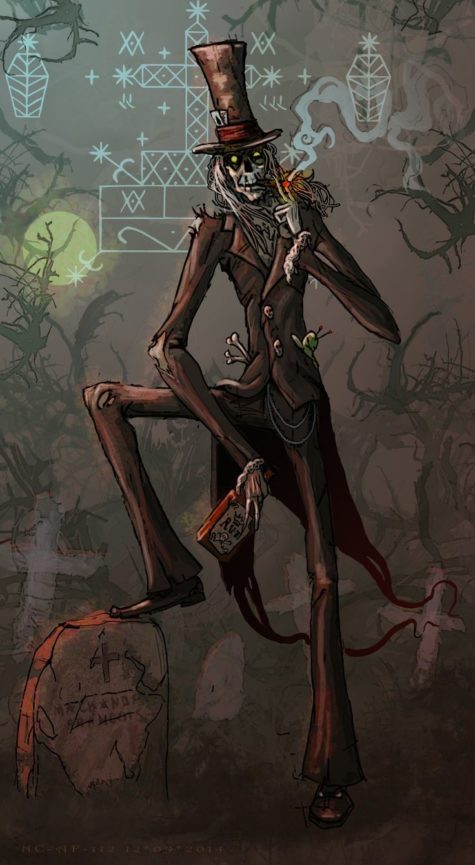 Baron Samedi manifests as an older, dark-skinned man in formal attire, dressed completely in black. He wears a black top hat, black suit, and may be smoking one of his beloved cigars. He wears impenetrable black sunglasses.
Baron Samedi manifests as an older, dark-skinned man in formal attire, dressed completely in black. He wears a black top hat, black suit, and may be smoking one of his beloved cigars. He wears impenetrable black sunglasses.
- The glasses may be missing a lens because he possesses two kinds of vision: he simultaneously sees the realms of the living and the dead.
- Alternatively his glasses have but one lens because a penis has but one eye and the phallus is his attribute (and because he loves sexual humor and innuendo.)
He is usually depicted with a top hat, black tail coat, dark glasses, and cotton plugs in the nostrils, as if to resemble a corpse dressed and prepared for burial in the Haitian style. He has a white, frequently skull-like face (or actually has a skull for a face), and speaks in a nasally voice. The former President for Life of Haiti, François Duvalier, modeled his cult of personality on Baron Samedi; he was often seen speaking in a deep nasal tone and wearing dark glasses.
- Favored People
Children; women seeking to conceive; funeral workers; grave diggers; those whose work brings them into contact with death.
Connection to other loas:
Baron Samedi is the leader of the Guédé, loa with particular links to magic, ancestor worship and death. Samedi is a loa of the dead, along with Baron’s numerous other incarnations Baron Cimetière, Baron La Croix, and Baron Kriminel. These lesser spirits, all dressed like the Baron, are all as rude and crude, but not nearly as charming as their master. They help carry the dead to the underworld.
Working with Baron Samedi
- Iconography: Baron Samedi’s throne is a chair chained to a cross. Images of Darth Vader are supposed to represent him (or just to decorate his altar; he likes toys)
- Attributes: Coffin; phallus, skull and crossbones; shovel; grave; black sunglasses; cross
As well as being master of the dead, Baron Samedi is also a giver of life. He can cure any mortal of any disease or wound, if he thinks it is worthwhile. His powers are especially great when it comes to vodou curses and black magic. Even if somebody has been afflicted by a hex that brings them to the verge of death, they will not die if the Baron refuses to dig their grave. So long as this mighty spirit keeps them out of the ground, they are safe.
He also ensures that all corpses rot in the ground to stop any soul from being brought back as a brainless zombie. What he demands in return depends on his mood. Sometimes he is content with his followers wearing black, white or purple clothes or using sacred objects; he may simply ask for a small gift of cigars, rum, black coffee, grilled peanuts, or bread. But sometimes the Baron requires a vodou ceremony to help him cross over into this world.
- Offerings
Black coffee, plain bread, dry toast, roasted peanuts. He drinks rum in which twenty-one very hot peppers have been steeped. Cigars, cigarettes, dark sun glasses, Day of the Dead toys, the sexier and more macabre the better; raise a skull and crossbones pirate flag for him, beautiful wrought-iron crosses are crafted in his honor.
- Veve
The veve or symbol for Baron Samedi is as follows:
Sources: Wikipedia and Encyclopedia of Spirits
- Origin: Japan
- Classification: Kami
- Color: Red
- Offerings: Rice with red adzuki beans
Hosogami are smallpox spirits. (Hoso is the Japanese word for smallpox.) For safe recovery to health, the Hosogami must be soothed, propitiated, and sent on their way. Hosogami are pleased to see the color red. Physicians were glad to see the color red too:
- Purple smallpox rashes indicate the illness is in a dangerous stage.
- If and when rashes turn red, the patient is expected to recover.
The person suffering from small pox and those caring for him dressed in red to appease the Hosogami. In addition, “red prints” or hoso-e prints, paper wall amulets were posted at the first hint of small pox to propitiate, avoid, and/or banish the illness.
Daruma and Shoki possess the power to expel Hosogami and are among the spirits portrayed on red smallpox talismans.They are called “red” because that’s the primary color of these prints. If no print is available, red banners may suffice.
Following the patient’s recovery, these prints were traditionally ritually burned or floated down rivers to signal the departure of the spirit. Extremely few survive and these are now extremely valuable collectors items.
Source: Encyclopedia of Spirits
Lugh (pronounced LOO) was known to the Celts as a god of craftsmanship and skill — in fact, he was known as the Many-Skilled God, because he was good at so many different things. In one legend, Lugh arrives at Tara, and is denied entrance. He enumerates all the great things he can do, and each time the guard says, “Sorry, we’ve already got someone here who can do that.” Finally Lugh asks, “Ah, but do you have anyone here who can do them ALL?”
- Origin: Celtic
- Attributes: Magical spear, harp
- Bird: Raven
- Animal: Lion, horse
- Planet: Sun
- Plant: Red corn cockles
Lugh, Lord of Craftsmanship, Light, Victory and War, is a master builder, harpist, poet, warrior, sorcerer, metalworker, cupbearer and physician. It’s hard to envision anything at which Lugh does not excel.
- Also known as:
Lug, Luc, Lugos, Lleu Llaw Gyffes, Bright One of the Skillful Hand - Favored people:
Artisans, crafts people, poets, artists, physicians, soldiers, and warriors. - Manifestation:
Shining, handsome, charming and witty. He has a silver tongue to match his skillful hands. - Consorts:
Lugh has different consorts in different locations but he was frequently linked to Rosemerta. - Spirit Allies:
Lugh shared the city of Lyon with Kybele and Paris with Isis. In battle, Lugh used his own weapons but also those belonging to Manannan.
Lugh was venerated throughout the ancient Celtic world. Modern scholars perceive him as especially significant because his veneration indicates the existence of pan-Celtic spiritual traditions. (Celts once ruled a huge swathe of continental Europe before being forced to the very edges of the continent.)
At least fourteen European cities are named for Lugh including Laon, Leyden, Loudon and Lyon. Lyon’s old name was Lugduhum, meaning “Lugh’s Fort.” Tat city is believed to have been his cult center. Its coins bore the images of ravens which may be a reference to Lugh. Carlisle in England, the former Lugubalium, is also named in Lugh’s honor. Some theorize that Lugh’s name is reflected in an older name for paris: Lutetia.
The Romans identified Lugh with Mercury. Many European churches dedicated to Michael the Archangel are believed to have been built over sites once dedicated to Lugh. Post-Christianity many of Lugh’s sacred functions were reassigned to saints like Patrick and Luke.
Lugh apparently traveled westward through Europe. Irish and Welsh myths describe his first appearance in their pantheon. He is greeted with resistance from women in Wales. His first public act in Ireland is to join battle with the Tuatha De Danaan (his father’s people) against the Fomorian, his mother’s people. Lugh chooses allegiance with the paternal line; the myth may be interpreted as indicating the beginnings of patriarchy in Ireland.
- Feast: August 1st
August 1st is the festival of Lughnasadh. Lughnasadh (sometimes spelled Lughnasa) means “the marriage of Lugh.” Lugh the sun and the Earth Mother renew their wedding vows annually during the full moon in August and invite all to gather and revel with them. Lughnasadh celebrates the consummation of their sacred relationship.
Once upon a time, Lughnasadh was a four week festival.: the last two weeks of July and the first two weeks of August, roughly corresponding to when the sun is in Leo, the astrological sign that belongs to the sun and epitomizes its power. In modern Irish Gaelic, the month of August is Lunasa. However the modern Wiccan sabbat of Lughnasadh is almost always devoted solely to the eve of July 31 leading into Lughnasadh Day on August 1st.
Celebrating Lugh Today:
Lughnasadh is a pagan holiday is dedicated to this capable God, and is celebrated every year on August 1st.
Take the opportunity this day to celebrate your own skills and abilities, and make an offering to Lugh to honor him, the god of craftsmanship.
Here’s How:
Before you begin, take a personal inventory. What are your strong points? Everyone has a talent — some have many, some have one that they’re really good at. Are you a poet or writer? Do you sing? How about needlecraft, woodworking, or beading? Can you tap dance? Do you cook? How about painting? Think about all the things you can do — and all of the things you’d like to learn to do, and the things you’d like to get better at. Once you sit down and think about it, you might be surprised to realize how accomplished you really are.
Decorate your altar with items related to your skill or talent. If your skill relates to something tangible, like sewing or jewelry-making, put some of your craft supplies on the altar. If it’s an ability to DO, rather than MAKE, such as dancing or singing, put some symbol of your ability on your altar. Do you have a favorite outfit you wear when you dance? A particular song lyric that you know you’re fabulous with? Add as many items as you like to your altar.
You’ll need a candle to symbolize Lugh, the god. Any harvest color is good, because he came up with the idea of a grain festival to honor his foster mother, Tailtiu. Place the candle on your altar in the center. Feel free to add some stalks of grain if you like — you can combine this rite with one honoring the harvest, if you choose.
Light the candle, and take a moment to think about all the things you are good at. What are they? Are you proud of your accomplishments? Now’s your chance to boast a little, and take some pride in what you’ve learned to do.
Announce your own talents in the following incantation. Say:
Mighty Lugh, the many-skilled god,
he who is a patron of the arts,
a master of trades, and a silver-tongued bard.
Today I honor you, for I am skilled as well.
I am deft with a needle,
strong of voice,
and paint beauty with my brush strokes.*
*Obviously, you would insert your pride in your own skills here.
Now, consider what you wish to improve upon. Is your tennis-playing out of whack? Do you feel inadequate at bungee jumping, yodeling, or drawing?
Now’s the time to ask Lugh for his blessing. Say:
Lugh, many-skilled one,
I ask you to shine upon me.
Share your gifts with me,
and make me strong in skill.
At this time, you should make an offering of some sort. The ancients made offerings in exchange for the blessings of their gods — quite simply, petitioning a god was a reciprocal act, a system of exchange. Your offering can a tangible one: grain, fruit, wine, or even a sample of your own talents and skills — imagine dedicating a song or painting to Lugh. It can also be an offering of time or loyalty. Whatever it is, it should come from the heart.
Say:
I thank you, mighty Lugh, for hearing my words tonight.
I thank you for blessing me with the skills I have.
I make this offering of (whatever it is you are offering) to you
as a small token of honor.
Take a few more moments and reflect on your own abilities. Do you have faith in your skills, or do you deflect compliments from others? Are you insecure about your abilities, or do you feel a surge of pride when you sew/dance/sing/hula hoop? Meditate on your offering to Lugh for a few moments, and when you are ready, end the ritual.
Tips:
If you are performing this rite as part of a group, family or coven setting, go around in a circle and have each person take their turn to express their pride in their work, and to make their offerings to Lugh.
Sources: Encyclopedia of Spirits and PaganWiccan
Bona Dea (“The Good Goddess”) was a divinity in ancient Roman religion. She was associated with chastity and fertility in women, healing, and the protection of the Roman state and people. According to Roman literary sources, she was brought from Magna Graecia at some time during the early or middle Republic, and was given her own state cult on the Aventine Hill.
Bona Dea was worshipped only by women. In fact, the presence of a man at rites in her honor were a sacrilige. May 1 was the annual, state-sponsored festival to Bona Dea at her temple. In early December, there was another private festival as well.
Her rites allowed women the use of strong wine and blood-sacrifice, things otherwise forbidden them by Roman tradition. Men were barred from her mysteries and the possession of her true name. Given that male authors had limited knowledge of her rites and attributes, ancient speculations about her identity abound, among them that she was an aspect of Terra, Ops, the Magna Mater, or Ceres, or a Latin form of Damia. Most often, she was identified as the wife, sister or daughter of the god Faunus, thus an equivalent or aspect of the nature-goddess Fauna, who could prophesy the fates of women.
The Good Goddess was a patron of the good of the earth and of chastity and fertility in women, she was invoked for healing and for freedom from slavery. Many of her worshippers were freed slaves and plebians, and many were women seeking aid in sickness or for fertility. She was also considered a protector from earthquakes.
Bona Dea was sometimes depicted with a scepter, vine leaves, wine, and a serpent, usually curled around her arm. Sometimes she was depicted seated, holding a cornucopia. Her image appeared on many coins.
The temple to Bona Dea in Rome stood over an overhanging rock, or cave, and both serpents and healing herbs are associated with the cave. The temple contained many kinds of healing herbs and snakes (both associated with medicine). Men were not allowed in her temple or at her festivals, nor were male animals.
The temple was decorated with vine-branches, and other plants and flowers (although myrtle was not permitted). Wine was served, but it was referred to as “milk” and the jar in which it was served, a “honey-pot.” A sow was sacrificed to her at the ritual.
Another ceremony was held in December in honor of the Bona Dea. The rites were conducted annually by the wife of the senior magistrate present in Rome in his home. She was assisted by the Vestal Virgins. The December rite was interesting because unlike the festival in May, it was not held in the goddess’ temple, not paid for by the state and the night of its celebration was not fixed. Unlike the May celebration, the December ceremony was an invitation only affair and pretty exclusive.
The celebrations for the Bona Dea seem to have been in the nature of a mystery cult. Men were strictly forbidden and the details that we have of the ceremony are from a late source, Macrobius. The worship seems to have been agricultural in origin and the careful exclusion of myrtle (associated with flagellation) may actually suggest origins as a purification ceremony.
In the year 62 BCE, the celebration was held in the home of Julius Caesar, then praetor and Pontifex Maximus, on December 3rd. His wife Pompeia and his mother, Aurelia, were in charge. A notorious Roman politician, Publius Clodius, dressed up as a woman and sneaked into the house. He was eventually caught by Caesar’s mother and kicked out. The ceremony had to be performed anew.
Caesar divorced his wife over it (claiming even she had to be above suspicion). Publius Clodius was sued and at his trial Cicero blew his alibi. The two became mortal enemies over the affair. The rites seemed to have fallen into disrepute over the events, and by the early empire, Juvenal suggested that it was nothing but a drunken orgy for girls.
Collected from various sources including: Women’s History, Ancient History, and Wikipedia
- Other names: Damballah Weddo, Da, Papa Damballa, Obatala
- Manifestation: Damballah is a huge snake, so big his body forms seven thousand coils
- Color: White
- Day: Thursday
- Plants: Bougainvillea, trees in general, but especially the silk cotton tree (Bombax ceiba) and the Royal palm.
- Altar: Keep shallow vessels of clean, fresh water for him to curl up inside.
- Holiday: March 17 (St. Patrick’s Day)
Once upon a time, there was only Damballah. He lay beneath Earth, a great snake, cushioning and protecting it from falling into the watery abyss below. Although he lay still for a long time, eventually he had to move. His movements raised mountains and created valleys. Stars were shaken up into the sky. Sacred waters were released, forming oceans, rivers, springs and streams.
The first rain began to fall, and Aido-Hwedo, in the guise of the first rainbow, appeared. Damballah and Aido-Hwedo fell in love. They remain in love today. The intensive all pervasive power of that love infiltrated the entire universe. That power is manifest in human beings in the form of white liquids: milk and semen.
Associated Catholic Saint Patrick (who drove the snakes out of Ireland), and sometimes also Moses, whose staff transformed into a snake to prove the power of God over that wielded by Egyptian priests, Damballah is the primordial snake Iwa of life, wealth and wisdom. He is venerated in Dahomey as well as Haitian Vodou. He may also survive in the New Orleans folk saint Blanc Dani.
Damballah is among the most beloved and important Iwa. He associated with creation and is viewed as a loving father to the world. His presence brings peace and harmony. He bestows wealth, prosperity, good health, and fertility to devotees and can expose the location of missing treasure.
Damballah and his true love, the rainbow serpent, maintain the balance of forces, which sustains all ife on Earth. As a source of life, he is also strongly associated with water and regulates moisture and the rain.
He is incredibly old and powerful and is usually not bothered for trivial matters. He can be extremely generous, however, and so may be approached when one is genuinely desperate or really in trouble. Despite his venerable age, he remains interested in people. He will engage in sacred marriages with women but also occasionally with men.
Dambullah appears in dreams. He does not communicate well. You must pay attention. He is so old and primal that he is pre-articulate; he emerges from a time before speech. Damballah may hiss or make whistling noises but does not speak human language.
When he possesses a human, he does not speak but instead only hisses and whistles. His movements are also snake-like, and can including slithering along the ground, flicking his tongue, and climbing tall objects.
He is a stickler for cleanliness. He doesn’t like strong, pervasive odors of any kind, but especially tobacco. If you smoke, then do so far from his altar space or anywhere associated with him. He may object to cleaning products with strong odors too, as well as air fresheners with strong aromas. Rooms should smell clean and fresh. Open a window to aerate them. He does not object to light floral odors, like rose or orange blossom water, and traditionally expresses a fondness for Pompeii Lotion, a cologne product found in botanicas and spiritual supply stores.
Offerings:
For a very traditional offering, make a bed or hill of white flour on a perfectly clean, pure white plate. Nestle one whole, raw white egg into the center of the flour and serve.
Other offerings could include white candles and white foods like rice, milk, whole raw eggs (leave them plain or rub gently with rose or other mildly scented, fine quality floral water), corn syrup, white chickens, or white flowers. More lavish offerings might include luxurious white fabrics, crystal or porcelain eggs and/or snakes.
Veve for Damballa and Ayida-Weddo:
From; Encyclopedia of Spirits
